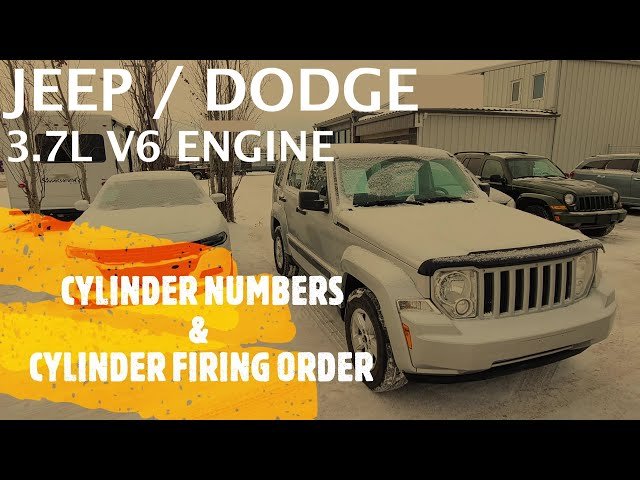2008 Jeep Grand Cherokee 3.7 Firing Order

The 2008 Jeep Grand Cherokee is a popular SUV known for its ruggedness and capability. A crucial aspect of its performance, especially concerning the 3.7-liter V6 engine, is the correct firing order. This article delves into the firing order for the 2008 Jeep Grand Cherokee equipped with the 3.7L engine, why it's essential, and the potential consequences of getting it wrong.
Understanding the 2008 Jeep Grand Cherokee 3.7L V6 Firing Order
The 2008 Jeep Grand Cherokee, when equipped with the 3.7-liter PowerTech V6 engine, utilizes a specific firing order to ensure smooth and efficient engine operation. The correct firing order is: 1-6-5-4-3-2. This sequence dictates the order in which the cylinders ignite during the combustion cycle. The cylinders are numbered as follows:
- Bank 1 (Passenger Side): 1-3-5 (front to back)
- Bank 2 (Driver Side): 2-4-6 (front to back)
This firing order is crucial because it optimizes the crankshaft's rotation and minimizes vibrations. It's carefully engineered by the manufacturer to provide the best balance and power delivery for this specific engine configuration.
Why is the Firing Order Important?
The firing order is paramount for several reasons:
- Efficient Combustion: The correct sequence ensures that each cylinder fires at the optimal time in relation to the crankshaft's position, maximizing combustion efficiency and power output.
- Smooth Engine Operation: An incorrect firing order can lead to significant engine vibration and roughness, making the driving experience unpleasant and potentially damaging engine components.
- Optimal Fuel Economy: Proper timing directly impacts fuel efficiency. A misfired cylinder, caused by an incorrect firing order, results in wasted fuel and reduced mileage.
- Reduced Emissions: Incomplete or inefficient combustion due to incorrect firing order increases harmful emissions, impacting air quality and potentially causing the vehicle to fail emissions tests.
- Prevention of Engine Damage: Continual operation with an incorrect firing order can stress engine components, leading to premature wear and potentially catastrophic engine failure.
Consequences of an Incorrect Firing Order
If the firing order is incorrect, a range of problems can occur. Some common symptoms include:
- Engine Misfires: This is a frequent symptom. A misfire occurs when a cylinder fails to ignite the air-fuel mixture properly, leading to a noticeable jerk or stumble in the engine's performance. Your check engine light will likely illuminate.
- Rough Idling: The engine may idle unevenly and vibrate excessively.
- Reduced Power: The engine will feel sluggish and unresponsive. Acceleration will be significantly affected.
- Poor Fuel Economy: You'll notice a drop in gas mileage.
- Backfiring: Unburnt fuel may ignite in the exhaust system, causing a loud pop or bang.
- Difficulty Starting: In some cases, an incorrect firing order can make the engine very difficult or impossible to start.
In severe cases, prolonged operation with an incorrect firing order can damage the catalytic converter, sensors, and even internal engine components such as pistons and connecting rods. Diagnosing a firing order issue often involves checking spark plug wiring, ignition coils, and using a scan tool to read diagnostic trouble codes (DTCs) indicating misfires.
Practical Applications and Troubleshooting
Knowing the firing order is essential when performing various maintenance and repair tasks. For example, when replacing spark plugs or ignition coils, it's critical to ensure that the wiring is connected correctly according to the 1-6-5-4-3-2 sequence. Double-check your work before starting the engine.
If you suspect a firing order problem, use a diagnostic scanner to read DTCs. Codes such as P0300 (Random Misfire Detected) or P0301 through P0306 (Cylinder X Misfire Detected) can indicate a problem. Remember to consult a repair manual or reputable online resource for specific troubleshooting procedures for the 2008 Jeep Grand Cherokee 3.7L engine.
Always disconnect the negative battery terminal before working on the ignition system to prevent electrical shock and damage to sensitive electronic components. If you are not comfortable working on your engine, it's best to consult a qualified mechanic.
Conclusion
Maintaining the correct firing order of 1-6-5-4-3-2 is crucial for the proper operation and longevity of the 2008 Jeep Grand Cherokee's 3.7L V6 engine. Understanding the firing order and its significance can help enthusiasts, mechanics, and owners alike diagnose and address potential problems, ensuring optimal performance and reliability of this popular SUV.
